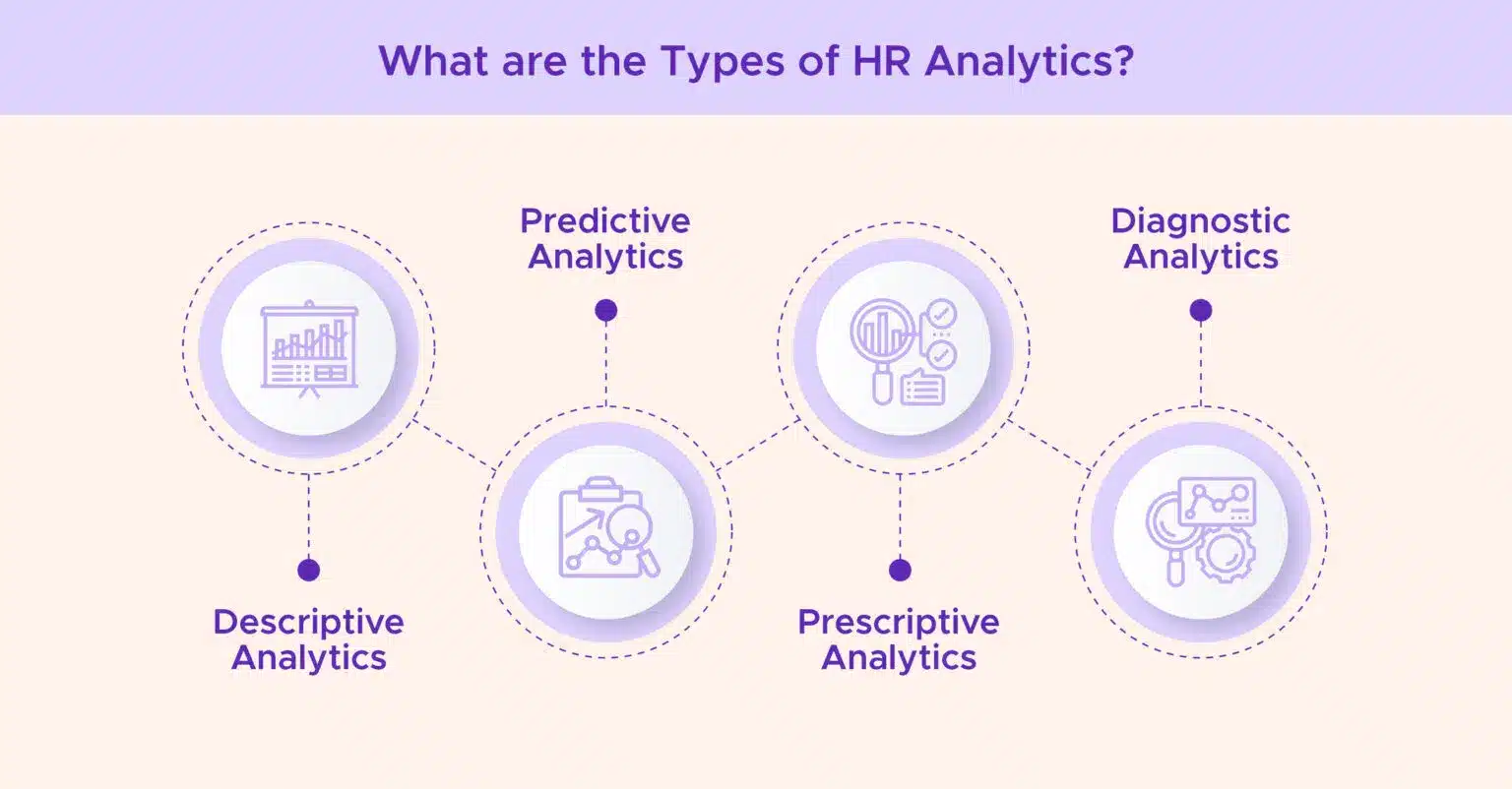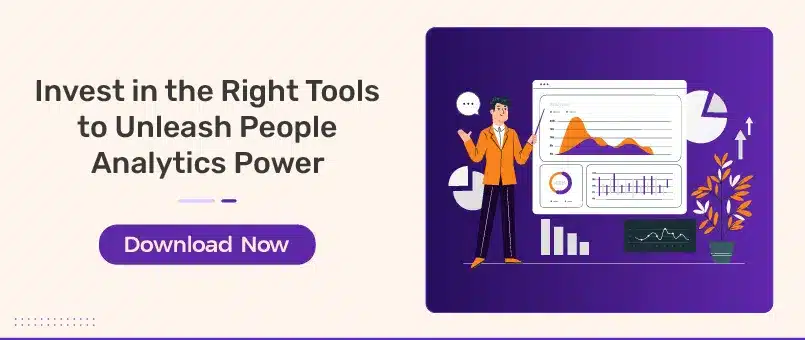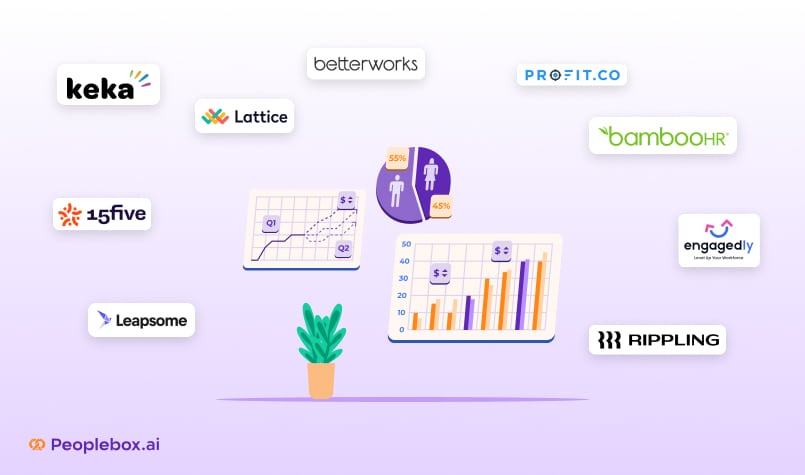Imagine you’re a manager at a tech startup. Your team is talented and driven, but lately, you’ve noticed a dip in overall productivity. Some team members seem to be exceeding expectations, while others are struggling to meet their goals. Is it a problem with talent management? Gut feelings tell you there might be skill gaps or motivational issues, but pinpointing the exact cause is a challenge.
This is where HR analytics steps in. Wondering how? In this blog post, we tell you everything you need to know about HR analytics to improve your team’s performance and efficiency. Read along!

What is HR Analytics?
HR analytics, also sometimes referred to as people analytics or workforce analytics, is the practice of collecting, analyzing, and interpreting data related to your organization’s human resources. It’s essentially using the power of data to gain deeper insights into your workforce and make more informed decisions about your most valuable asset: your people.
This data can come from a variety of sources, including:
- Applicant Tracking Systems (ATS)
- Human Resource Information Systems (HRIS)
- Payroll data
- Performance management systems
- Employee surveys
- Training records
Did you know we have our own HR analytics solution? Be the first to access it.

Why Is Human Resources Analytics Important?
One might ask, haven’t HR professionals managed just fine for years using intuition and experience? The truth is, while experience is valuable, relying solely on gut feelings can be a gamble. Here’s why HR analytics is a powerful ally:
- Increased Retention: Analyzing turnover data can uncover reasons for employee attrition, allowing companies to take proactive steps to improve retention.
- Better alignment to business objectives: By analyzing HR data, organizations can ensure that their HR strategies and practices are in sync with broader business goals. For instance, a retail company might use analytics to ensure that its workforce planning supports its expansion into new markets.
- Data-driven Decision Making: HR analytics empowers decision-makers with insights derived from data, enabling them to make informed choices. For instance, analyzing employee performance data might reveal patterns that inform decisions about training and development initiatives.
- Improved Recruitment: Analyzing recruitment data can help organizations identify the most effective sourcing channels and candidate characteristics, leading to better hiring decisions.
- Enhanced Employee Engagement: By analyzing employee feedback, sentiment, and engagement survey data, organizations can identify factors that influence employee engagement and take targeted actions to improve it. For example, analyzing survey data might reveal that employees value opportunities for professional development, prompting the organization to invest in training programs.
- Cost Reduction: HR analytics can help identify inefficiencies in HR processes, enabling organizations to streamline operations and reduce costs. For instance, analyzing time-to-fill metrics might reveal bottlenecks in the recruitment process, prompting the organization to implement measures to expedite the hiring.
- Strategic Planning: By analyzing workforce demographics, skills gaps, and succession planning data, organizations can develop long-term strategic plans to ensure they have the right talent in place to achieve their goals. For instance, analyzing retirement projections might prompt an organization to implement knowledge transfer programs to capture critical institutional knowledge before employees retire.
- Performance Management: HR analytics can provide insights into individual and team performance, enabling organizations to identify top performers, address performance issues, and allocate resources effectively. For example, analyzing sales performance data might reveal which sales strategies are most effective, allowing the organization to focus its efforts on high-performing tactics.
- Compliance and Risk Management: By analyzing HR data, organizations can ensure compliance with labor laws, regulations, and internal policies. For instance, analyzing employee time and attendance data can help organizations identify and address potential compliance issues related to overtime and wage laws.
- Competitive Advantage: Ultimately, organizations that effectively leverage talent analytics gain a competitive advantage by optimizing their workforce, improving productivity, and attracting and retaining top talent. For example, a technology company might use analytics to identify emerging skill trends in the industry and adjust its talent acquisition strategy accordingly.

What are the Types of HR Data Analytics?
We’ve established the significant advantages of HR analytics in transforming HR practices. But how exactly does it work? HR analytics utilizes various analytical techniques to extract valuable insights from your people data. Here are the four main types of HR analytics:

Descriptive Analytics: This is the foundation, providing a historical view of your HR data. Think of it as understanding your organization’s story through past trends and events. Descriptive analytics helps you summarize key metrics like employee demographics, employee turnover rates, and performance data.
By analyzing this historical data, you can identify patterns, for example, if a specific department experiences higher turnover or if certain demographics are underrepresented in leadership positions.
Predictive HR Analytics: Moving beyond the past, predictive analytics leverages historical HR data and statistical algorithms to forecast future trends. Imagine being able to anticipate potential challenges before they arise. Predictive model can help you foresee issues like employee flight risk or emerging skill gaps within your workforce.
With this foresight, you can take proactive measures, such as implementing targeted retention programs or developing upskilling initiatives.
Prescriptive Analytics: This powerful technique goes a step further by not only predicting future outcomes but also recommending specific actions or strategies to address them. Think of it as having a built-in consultant analyzing the different types of data and suggesting solutions. Building on insights from predictive analytics, prescriptive analytics can recommend interventions tailored to the specific challenges identified.
For instance, it might suggest personalized training programs to address skill gaps or recommend adjustments to compensation packages to improve employee retention.
Diagnostic Analytics: While predictive analytics anticipates what might happen, diagnostic analytics focuses on understanding the “why” behind current trends. Imagine having a detective hat on, digging deeper to uncover the root causes of HR-related issues. Diagnostic analytics helps you delve into the reasons behind specific HR metrics.
For example, if you see a dip in employee engagement scores, HR data analysis through diagnostic analytics can help you identify factors contributing to this, such as workload imbalances or lack of recognition programs. This deeper understanding empowers you to develop targeted interventions for improvement.
Building Your HR Analytics Foundation: Metrics and Data
The power of HR analytics hinges on a strong foundation – the right metrics and robust data collection strategies.
HR metrics are the quantifiable measures that track various aspects of your workforce. They serve as the building blocks of HR analytics, providing the raw data for analysis and insights. The importance of HR metrics cannot be overstated. Here’s why:
- Visibility and Accountability: Metrics bring transparency to your HR practices. By tracking key indicators, you can assess progress towards goals, identify areas for improvement, and demonstrate the impact of HR initiatives.
- Data-Driven Decision Making: Intuition and anecdotal evidence have their place, but quality data reigns supreme in today’s world. HR metrics provide the objective data foundation for making informed decisions about your most valuable asset – your people.
- Benchmarking and Continuous Improvement: Metrics allow you to compare your business performance with industry benchmarks. This comparative analysis helps you identify areas where you excel and pinpoint opportunities for improvement, propelling your HR practices forward.
Remember, what gets measured gets managed. By implementing a robust HR metrics framework, you empower yourself to take a data-driven approach to managing your workforce.
Identifying the Right Metrics
Different HR functions require different metrics. A one-size-fits-all approach won’t work. The key is to identify the metrics most relevant to your specific goals and challenges within each HR function. Here are some examples:
| HR Function | Sample Metrics |
| Recruitment | Time-to-fill, Cost-per-hire, Quality of hire (retention rate of new hires after a specific period), Offer acceptance rate, Number of applications per job posting |
| Training | Training completion rates, Employee satisfaction with training programs, Impact of training on performance metrics, Cost per training program participant |
| Performance Management | Performance ratings, Goal achievement, Development needs, Skills gaps identified through performance reviews |
| Employee Engagement | Employee satisfaction scores, Participation rates in surveys and wellness programs, Absenteeism rates, Stay interviews conducted |
| Compensation and Benefits | Salary satisfaction ratings, Turnover rates by compensation level, Usage rates of employee benefits programs, Cost of employee benefits as a percentage of total payroll |
By focusing on the right metrics, you gain targeted insights that enable you to make informed decisions within each HR function.
Data Collection Strategies
We’ve established the importance of identifying the right HR metrics for your organization. But even the most well-defined metrics are useless if the underlying data is inaccurate or unusable. Here’s how to ensure your data collection strategies are robust and lay the foundation for reliable HR analytics:
1. Leverage Technology:
- HRIS as the Central Hub: Your HR information system (HRIS) should be the central repository for all employee data. Standardize data entry procedures across your HR team to ensure consistency and accuracy. Utilize features like automated data feeds from payroll systems and applicant tracking systems (ATS) to minimize manual entry and reduce errors.
- Integration is Key: Break down data silos by integrating your HRIS with other relevant enterprise systems. This could include performance management software, learning management systems, and even employee experience platforms. Streamlined data integration creates a holistic view of your workforce, allowing you to analyze trends and identify correlations across different data sets.
2. Prioritize Employee Input:
- Employee Surveys and Feedback: Employee surveys are a goldmine of valuable insights. Conduct regular surveys to gauge employee sentiment, engagement levels, and development needs. Utilize a mix of open-ended and closed-ended questions to gather both quantitative and qualitative data.
- Pulse Surveys and Stay Interviews: Complement traditional annual surveys with shorter, more frequent pulse surveys to capture real-time feedback on specific initiatives or company culture changes. Conduct stay interviews with high-performing employees to understand their motivations and identify potential retention risks.

3. Establish Data Governance Practices:
- Define Data Ownership and Access: Clearly define who is responsible for collecting, maintaining, and updating specific data sets within your HR team. Establish access control protocols to ensure data security and prevent unauthorized modifications.
- Implement Data Quality Checks: Regularly audit your data for accuracy and completeness. Utilize data validation techniques to identify and rectify inconsistencies. Consider using data cleansing tools to automate this process and ensure the integrity of your data.
- Standardize Data Collection: Develop standardized procedures for data entry and data management. This includes defining clear data formats, establishing naming conventions, and outlining protocols for handling missing data points. Consistent data
Remember, garbage in, garbage out – investing in robust data collection practices is an essential first step in your HR analytics journey. What are the next steps? Let’s have a look.
Step-by-Step Guide to Implementing HR Analytics
You’ve grasped the importance of HR analytics and established a solid data foundation. Now, let’s translate theory into action. Here’s a quick guide to get you started with HR analytics:
But before that, experience our future-ready people analytics platform yourself.
1. Define Your Objectives:
The first step is to clearly define your goals for HR analytics. What are you hoping to achieve? Here are some examples:
- Reduce time-to-hire and improve recruitment effectiveness.
- Boost employee engagement and retention.
- Identify and address skill gaps within your workforce.
- Optimize compensation and benefits packages.
By outlining your specific objectives, you can tailor your HR analytics initiatives to address your most pressing challenges.
2. Assess Your Data Availability:
Before diving into analysis, take stock of the HR data currently available within your organization. Identify data sources like your HRIS, payroll system, performance management software, and employee surveys. Evaluate the completeness and accuracy of this data. Are there any data gaps that need to be addressed? This assessment helps determine your starting point and may reveal areas where you need to enhance your data collection practices.
3. Identify Key Metrics:
Based on your defined objectives and your data availability, identify the key HR metrics that will provide the most valuable insights for your specific needs. Refer back to the table in the previous section (Metrics by HR Function) as a starting point, but remember to customize these metrics to your unique goals.
4. Choose the Right Analytics Tools:
There are various HR analytics tools available, ranging from basic reporting functionalities within your HRIS to more advanced software solutions offering sophisticated data visualization and predictive analytics capabilities. Evaluate your needs and budget to select the tools that best suit your current stage and future aspirations within HR analytics.

5. Build Your Data Infrastructure:
Establish a secure and efficient system for storing, managing, and accessing your HR data. This may involve setting up data warehouses or utilizing cloud-based data storage solutions. Ensure your data infrastructure facilitates easy retrieval and integration of data sets for seamless analysis.
6. Conduct Data Analysis:
Now comes the exciting part – analyzing your data! Leverage your chosen HR analytics tools and techniques to explore your data sets and uncover hidden patterns and trends. Depending on your objectives, you might employ descriptive analytics to understand historical trends, predictive analytics to forecast future business outcomes, or prescriptive analytics to identify optimal courses of action.
7. Interpret Your Results:
Don’t just collect data and generate reports – the true value lies in interpreting your findings. Dig deeper to understand the “why” behind the trends you’ve identified. What do your results tell you about your workforce? Are there any areas that require improvement? Remember, context is key. Consider external factors that might influence your data, and avoid jumping to conclusions based solely on isolated metrics.
8. Implement Recommendations:
Based on your data-driven insights, develop actionable recommendations for improvement within your HR practices. This might involve changes to your recruitment strategy, adjustments to your compensation and benefits packages, or targeted training and development initiatives for your employees. Clearly communicate your recommendations to key stakeholders and secure buy-in for implementation.
9. Monitor and Evaluate:
HR analytics is an ongoing process. Continuously monitor the business impact of your implemented HR initiatives. Track relevant data to assess whether your changes are yielding the desired results. Be prepared to adapt your approach and refine your HR analytics practices over time based on your evolving needs and ongoing data analysis.
Building a Data-Driven HR Culture: Best Practices
We’ve discussed time and again about the importance of building a data-driven culture. Here are some best practices to cultivate a data-driven HR culture within your organization:
Leadership Buy-In: Secure the commitment of your organization’s leadership team. Executive sponsorship is crucial for allocating resources, prioritizing HR analytics initiatives, and driving cultural change. Educate leaders on the potential of HR analytics to support strategic decision-making impacting the entire organization.
Cross-Functional Collaboration: HR analytics isn’t an HR-only endeavor. Break down data silos by fostering collaboration with other departments. Business leaders from finance, marketing, and operations can provide valuable context and insights for interpreting HR data. This cross-functional approach ensures your HR analytics initiatives address the organization’s needs holistically.
Communicate Insights Effectively: Don’t let your data insights gather dust in reports. Communicate findings effectively to various stakeholders – from leadership teams to HR managers and employees. Tailor your communication style to the audience, using clear visualizations and actionable recommendations. Foster a culture of data-driven discussions where insights inform decision-making across all levels.
Invest in Technology: The right technology is essential for collecting, storing, analyzing, and visualizing your HR data. Evaluate your needs and explore HR analytics tools that offer functionalities tailored to your current and future aspirations.
Leveraging Peoplebox for Powerful HR Analytics
Peoplebox offers a comprehensive people analytics platform that unifies your data, delivers AI-powered insights at your fingertips, prioritizes data security, and empowers everyone with real-time data visualizations. Ready to make impactful people decisions and drive a data-driven HR future? Join the Peoplebox waitlist today and be among the first to experience the future of people management!
Want to discuss how we can help? Talk to us today!







